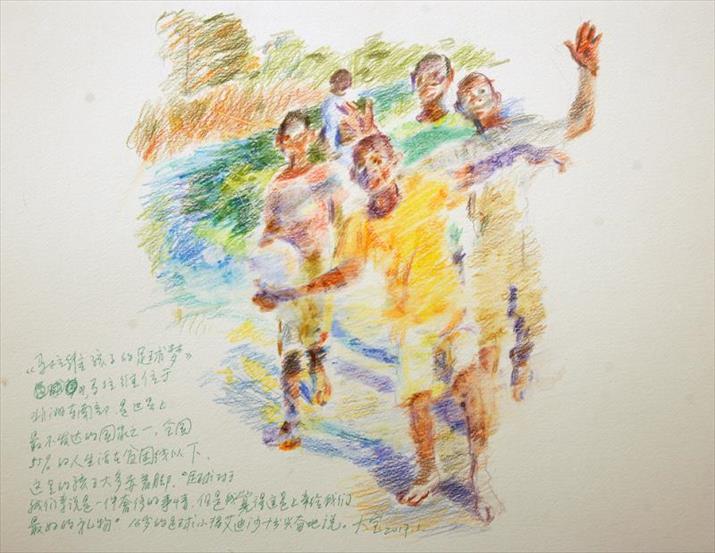|
||||||||||
| Home Nation World Business Opinion Lifestyle ChinAfrica Multimedia Columnists Documents Special Reports |
|
||||||||||
| Home Nation World Business Opinion Lifestyle ChinAfrica Multimedia Columnists Documents Special Reports |
| Lifestyle |
| The African Canvas |
| Chinese artists find the inspiration for new creations on a journey to the continent |
| By François Dubé and Cui Xiaoqin | VOL. 9 April 2017 ·2017-03-30 |
A cultural mosaic
On February 15, the group again took the air and headed to the island of Mauritius, about 2,000 km off the coast of Africa. After a somewhat turbulent flight, the five artists set foot on Mauritian soil, relieved and charmed by the tranquility of the island.
On arrival, they visited Cap Malheureux and its emblematic red-roofed church, the Sugar Cane Museum, and a Chinese temple, erected in the 19th century by descendants of immigrants from south China's Guangdong Province.
The peaceful coexistence and mix of multiple cultures and people on the island create a mosaic bursting with charm. Inspired by these cultural exchanges between Indians, Europeans, Chinese and indigenous people, Chen, seized the chance to sketch the locals.

A sketch drawn by Zhang Chun in Malawi
Now back in China, she has painted a set of four paintings showing the diversity of culture in the country. "I am interested in the lives of ordinary people in Mauritius, their livelihoods, their history," Chen said.
Among the paintings is the portrait of a serenely expressive old Indian woman in traditional dress. The painting, explains Chen, symbolizes the happiness of first-generation immigrants to Mauritius who can now enjoy life after years of hard work. Another painting depicts a couple of young women of Chinese and African origins respectively, taking a stroll together in Mauritius' Chinatown, a symbol of the island's strong cultural diversity.
"These paintings seek to express the stories told by these characters of different ages and appearances, and to show that people from different countries were able to build a comfortable life in Mauritius," Chen told ChinAfrica.
Heads and suitcases full
After such a short but very busy journey, the five artists returned home, their suitcases full of memories and their heads full of inspiration. In China, they transferred their impressions onto canvas, using their encounters and hastily drawn sketches as sources of reference.
The kinetic energy of African art, according to Wang, is what made the strongest impression on her, and she says she now wants to integrate these influences into her future creations.
"I like the primal nature of African art, because it is not completely mature, but it contains a lot of strength. It resembles works of the very beginnings of modernism, with natural, mysterious, specific elements," Wang told ChinAfrica. "African art remains inimitable, and its rhythm is definitely different from that of the rest of the world."
The Chinese can easily accept and acknowledge this form of art, as artists from China and Africa face substantially similar challenges, to which art is likely to bring insightful answers, according to Wang.
"Faced with industrialization and modernization from the West, both Chinese and African people must find their own way of coping with these shocks and living in peace with themselves and with the outside world," said Wang.
Likewise, Zhang believes that exchanges between artists from China and Africa can open doors to new ideas and help find solutions to the questions that are fundamental for both civilizations.
"How can we modernize without renouncing our past? How can we conserve our uniqueness while fully developing our capabilities and integrating perfectly into modernity? These are the common challenges facing Chinese and African arts," explained Zhang.
Fu, who was perhaps the most hesitant to embark on this journey, now feels it was absolutely worth the effort. As a matter of fact, he is considering going back again. He now feels he has grown through this experience because it enabled him to explore African art more deeply, opening doors leading to a completely different artistic world.
"Several great Western painters have been influenced and inspired by African arts," said Fu. "On this trip, I understood why this was so. From an evolutionary perspective, Africa is the cradle of humanity, and we can say the same thing from an artistic point of view."
| Previous1 |
| About Us | Contact Us | Advertise with Us | Subscribe |
| Copyright Beijing Review All rights reserved 京ICP备08005356号-5 京公网安备110102005860号 |